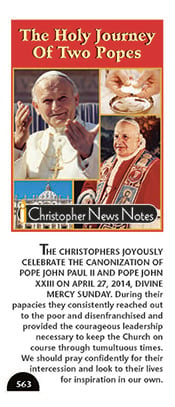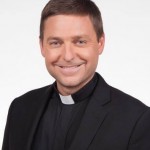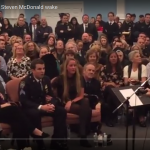 The following is the text of the Christopher News Note “The Holy Journey of Two Popes.” If you’d like a pdf or hard copy, see the end of this post:
The following is the text of the Christopher News Note “The Holy Journey of Two Popes.” If you’d like a pdf or hard copy, see the end of this post:
The Christophers joyously celebrate the canonization of Pope John Paul II and Pope John XXIII by the Vatican on April 27, 2014, Divine Mercy Sunday. During their papacies they consistently reached out to the poor and disenfranchised and provided the courageous leadership necessary to keep the Church on course through tumultuous times. We should pray confidently for their intercession and look to their lives for inspiration in our own.
A Pope of the People
It’s fitting that the plan to canonize John XXIII was announced during the 50th anniversary year of the opening of Vatican II. By calling the Council, he set in motion a four-year process that addressed the relation between the Church and the modern world, and ushered in greater accessibility within the faith as well as greater ecumenism towards other world religions.
Upon his election to the papacy, John became the first pope in almost 100 years to make pastoral visits around his home diocese of Rome. He visited the sick and infirm, and when he visited a prison, he announced to those incarcerated, “You could not come to me, so I came to you.”
A few years later, John visited a reformatory in Rome, where nearly 200 youth meticulously prepared for his arrival by scrubbing floors and painting walls. They greeted him with cries of “Il Papa, Il Papa! Bravo, Il Papa,” and he tearfully exhorted them to look beyond their circumstances and have hope in the future.
John was a tireless advocate for peace, and he understood that lasting peace could never come about without courageous leaders willing to stand against evil. Before becoming pope, as Bishop Angelo Roncalli, he assisted Jewish refugees and other endangered groups in their attempts to flee the Nazis. Later, as pope, he called all mankind to work for peace through civil dialogue and respect for human rights.
At the opening of his encyclical, Pacem in Terris, John writes, “Peace on earth — which man throughout the ages has so longed for and sought after — can never be established, never guaranteed, except by the diligent observance of the divinely established order.” Then later he writes: “May Christ inflame the desires of all men to break through the barriers that divide them, to strengthen the bonds of mutual love, to learn to understand one another, and to pardon those who have done them wrong.”
John XXIII also understood that a desire for peace required tremendous introspection in order to correct personal and institutional faults. He repented on behalf of Catholics for the sin of anti-Semitism that existed for centuries throughout Europe and elsewhere.
Both The Catholic Herald and Jewish scholar Pinchas Lapide have attributed the following prayer of reconciliation to John XXIII: “We are conscious today that many, many centuries of blindness have cloaked our eyes so that we can no longer see the beauty of Thy chosen people nor recognize in their faces the features of our privileged brethren…Forgive us for the curse we falsely attached to their name as Jews. Forgive us for crucifying Thee a second time in their flesh. For we know not what we did.”
John XXIII canonized several saints, including Martin de Porres, Juan de Ribera, and Maria Bertilla Boscardin. In 1959, he beatified Marie Marguerite d’Youville, who founded the Sisters of Charity of Montreal and would later become the first Canadian elevated to sainthood when John Paul II canonized her in 1990.
On October 11, 1962, at the end of the opening day of the Second Vatican Council, the people of Rome gathered in Saint Peter’s Square and chanted for John to appear. He came forth and gave his now famous impromptu “Speech to the Moon.” He spoke in his typical down-to-earth, fatherly manner and said: “All the world is represented here tonight. It could even be said that even the moon hastens close tonight, that from above, it might watch this spectacle that not even Saint Peter’s Basilica, over its four centuries of history, has ever been able to witness.” Then later he said, “When you head home, find your children. Hug and kiss your children and tell them: ‘This is the hug and kiss of the pope.’”
He came to be known as “Good Pope John,” and upon his death some of the Cardinals of the Second Vatican Council wanted to canonize him immediately. However, it wasn’t until September 3, 2000, that he was finally beatified by John Paul II, and since then numerous reports have been made about miracles, graces and favors due to his intercession. Though only one miracle has been officially confirmed, Pope Francis has decided to waive the usual two miracles necessary for canonization. This is not unprecedented and perfectly in keeping with canon law. Pope Francis simply wishes to recognize the holiness of the great pope of the Second Vatican Council.
A Pope for the World
While John XXIII made the papacy more accessible to the people of Rome, John Paul II made it accessible to the world. Throughout his time as pope, he visited 129 countries and became one of the most travelled world leaders ever. Some of the largest crowds in human history gathered to hear him speak, and he used the global stage to promote peace and justice for all mankind.
Before becoming pope, as the young Karol Wojtyla, he had to study in a clandestine seminary in Nazi-occupied Poland to even become a priest. He protected many Jews from the Nazis during the war and later showed great sensitivity to the plight of European Jews by insisting on more than one occasion that orphaned Jewish children, one of whom he personally helped to save, be raised in the faith of their ancestors.
As pope, he reached out to people of all faiths, and took steps to find common ground with other Christian denominations. And when he visited the Holocaust Memorial in Israel, he placed a letter inside the wall to ask forgiveness for sins against the Jewish people.
John Paul II returned to Poland during a time when communist governments of Central and Eastern Europe were trying to crush traditions, and he rallied the people to claim their right to religious freedom. He said, “Fidelity to roots is not a mechanical copying of the past. Fidelity to roots is always creative, ready to descend into the depths, open to new challenges.”
John Paul II also understood that injustice could occur under any government, and he exhorted leaders of all nations to uphold the natural law. In his encyclical, Evangelium Vitae, on the Value and Inviolability of Human Life, he writes: “There can be no true democracy without a recognition of every person’s dignity and without respect for his or her rights. Nor can there be true peace unless life is defended and promoted.”
In 1983, John Paul II made a prison visit to a man who had tried to assassinate him two and a half years before. Of their meeting he said: “What we talked about will have to remain a secret between him and me. I spoke to him as a brother whom I have pardoned and who has my complete trust.”
In the Jubilee year of 2000, John Paul II declared a Day of Jubilee for Prisoners and delivered this message: “The Jubilee reminds us that time belongs to God. Even time in prison does not escape God’s dominion. Public authorities who deprive human beings of their personal freedom as the law requires…must realize that they are not masters of the prisoners’ time. In the same way, those who are in detention must not live as if their time in prison had been taken from them completely: even time in prison is God’s time. As such it needs to be lived to the full; it is a time which needs to be offered to God as an occasion of truth, humility, expiation and even faith. The Jubilee serves to remind us that not only does time belong to God, but that the moments in which we succeed in ‘restoring’ all things in Christ become for us ‘a time of the Lord’s favour.’”
John Paul II highlighted countless examples of holiness by proclaiming 1,338 blesseds and canonizing 482 saints. In 1994, he beatified Gianna Beretta Molla, who sacrificed her life to carry a difficult pregnancy to term, and 10 years later he canonized her. John Paul’s canonization of Saint Gianna has particular significance because when his own mother was pregnant with him, doctors thought she had no chance of giving birth to a live child, so they advised her to terminate the pregnancy. But like Gianna she remained dedicated to her unborn child and carried the baby Karol to term.
In 2000, John Paul II canonized Maria Faustina Kowalska and established Divine Mercy Sunday on the first Sunday after Easter. A year later he said, “Jesus said to Sister Faustina one day: ‘Humanity will never find peace until it turns with trust to Divine Mercy.’ Divine Mercy! This is the Easter gift that the Church receives from the risen Christ and offers to humanity.”
It is fitting that John Paul II and John XXIII will be canonized on Divine Mercy Sunday because both men brought such mercy into the world. They were a living example of God’s immense love for us all and demonstrated a way of humble leadership that can transform the world. Let us pray that through their intercession as saints, the heavens will open wide and even the most hardened hearts will accept God’s gift of Divine Mercy.
Lord, we thank You for the holy examples of Pope John XXIII and Pope John Paul II. Through their intercession, may we be led ever deeper into the fullness of Your love, so that we can reflect that love to all Your children here on Earth, and eventually be united with You and all the saints in heaven. Amen.
To receive a pdf or mailed copy of “The Holy Journey of Two Popes,” email your request to [email protected]












